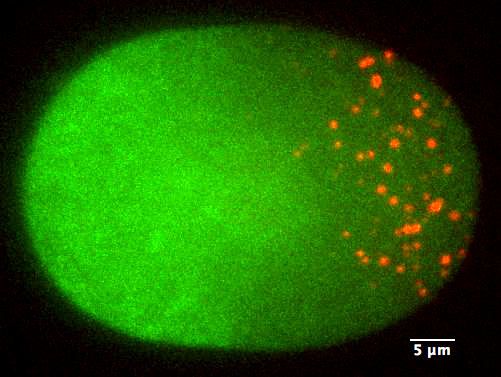
Distribution of P granules (red) and the regulator protein (green) in a one-cell stage C. elegans embryo (image courtesy: Carsten Hoege)
Cell organelles must be in the right place at the right time to do their job. While some organelles are bound by membranes, others are not. Cells transport membrane-bound organelles like trucks on a highway. Membranes are important for transport since ‘trucks’ of specialized motor proteins dock to the organelle membranes and transport them as cargo along ‘highways’ of cytoskeletal tracks. But how does a cell ensure that the other class of organelles, which lack a surrounding membrane and are liquid-like, are in the right place at the right time? How do you position a water droplet, so to speak?
We can make water droplets by cooling water vapor, but it is quite difficult to see how this can be done specifically at one place or another. A simple way could be to heat one end of a closed chamber while cooling the other end. Water droplets evaporate from the hot end and condense at the cold end. Researchers in the lab of Tony Hyman at the MPI-CBG discovered that cells use a similar mechanism to position liquid-like non-membrane-bound ‘P granule’ organelles to one of its two poles, a process critical for fertility in the worm C. elegans. Signals from the cell-polarity system concentrate a regulator protein at one of the two poles of the cell. This regulator protein dissolves P granules. The dissolved material at one pole then recondenses as P granules at the other pole where the regulator concentration is low.
While trying to understand how the regulator dissolves P granules, Shamba Saha and colleagues discovered that a novel competition mechanism is at the heart of this problem. P granule proteins must bind to messenger RNA (mRNA) molecules to make P granules. It turns out that the regulator and the P granule proteins compete for these mRNA molecules, such that P granules dissolve when the regulator protein sequesters mRNA molecules away from the P granule proteins. This competition mechanism represents a powerful way, distinct from ‘trucks on a highway’-based transport, of organizing the spatial distribution of liquid-like RNA-protein organelles in cells.
The study was a collaboration with colleagues from the Max Planck Institute for the Physics of Complex Systems in Dresden, the Max Planck Institute of Biochemistry, the Martin Luther University in Halle, and the Colorado State University, and was published in Cell.
Watch a video abstract by Shamba Saha, first author of the publication.
Shambaditya Saha, Christoph A. Weber, Marco Nousch, Omar Adame-Arana, Carsten Hoege, Marco Y. Hein, Erin Osborne-Nishimura, Julia Mahamid, Marcus Jahnel, Louise Jawerth, Andrej Pozniakovski, Christian R. Eckmann, Frank Jülicher, Anthony A. Hyman:
Polar Positioning of Phase-Separated Liquid Compartments in Cells Regulated by an mRNA Competition Mechanism
Cell, 8 September 2016